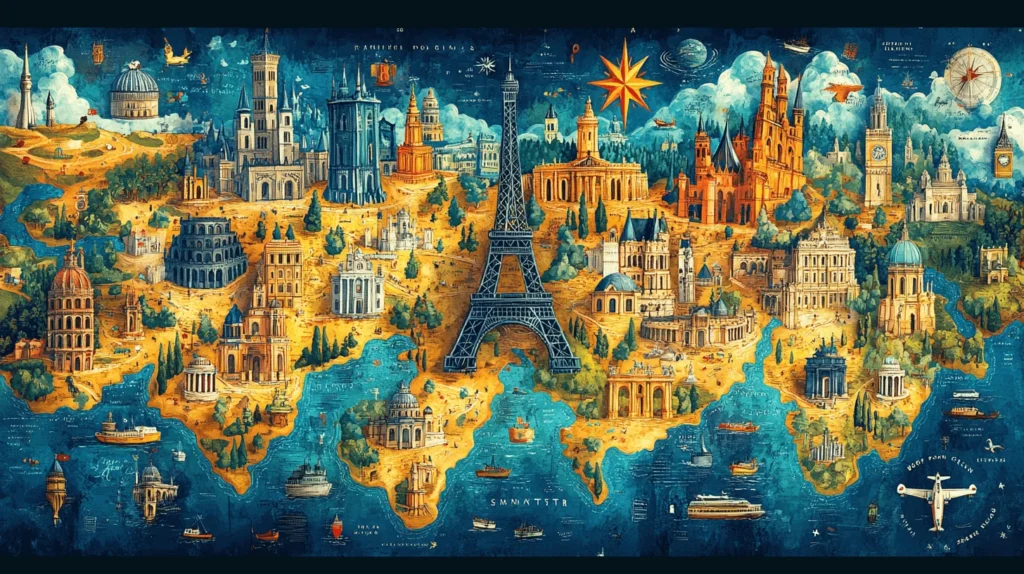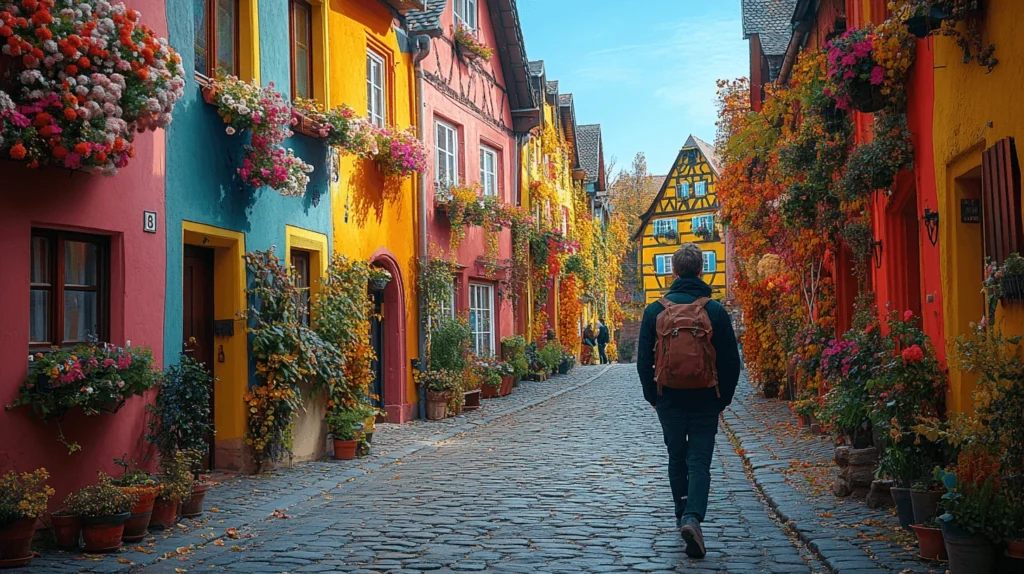Embarking on a multi-city European adventure is a dream for many travelers. With its rich history, diverse cultures, and stunning landscapes, Europe offers countless opportunities to explore iconic landmarks, hidden gems, and everything in between—all in a single trip. Whether you’re savoring croissants under the Eiffel Tower, wandering through ancient Roman ruins, or cruising along Amsterdam’s picturesque canals, the possibilities are endless.
However, planning a multi-destination journey can feel overwhelming. How do you decide which cities to visit? What’s the best way to travel between destinations? How can you stick to your budget while maximizing your experiences?
This ultimate guide is here to answer all those questions and more. From crafting the perfect itinerary and finding affordable transportation to budgeting tips and packing advice, we’ll help you navigate every step of your European adventure. By the end of this guide, you’ll be equipped with everything you need to turn your travel dreams into reality.
Let’s start planning the trip of a lifetime!
1: Choosing Your Destinations
Researching Top European Cities to Visit
Europe is home to some of the world’s most famous cities, each offering unique experiences, history, and culture. When planning a multi-city European adventure, start by identifying destinations that resonate with your travel goals. Are you drawn to art and architecture, vibrant nightlife, or serene countryside escapes?
- Iconic Cities: Consider must-visit cities like Paris for its romantic ambiance and landmarks, Rome for its ancient ruins, or London for its mix of tradition and modernity. These destinations are often rich in culture and history, making them ideal stops on your journey.
- Themed Destinations: Depending on your interests, explore cities like Florence for art and museums, Munich for beer gardens and Bavarian charm, or Santorini for stunning island views.
- Traveler Preferences: Look for cities that cater to your travel style. Foodies might enjoy the culinary delights of Barcelona, while nature lovers might opt for the alpine beauty of Innsbruck or Lake Bled.
Balancing Big Cities and Hidden Gems
To get the most out of your European adventure, strike a balance between visiting bustling metropolises and exploring quieter, less touristy towns. While big cities are packed with famous attractions, hidden gems offer a more authentic and laid-back experience.
- Why Mix Both: Big cities like Berlin or Vienna offer iconic sights and vibrant energy, but smaller towns like Český Krumlov (Czech Republic) or Colmar (France) let you immerse yourself in local culture without the crowds.
- Exploring Nearby Villages: Plan day trips to small villages or countryside areas near your major city destinations. For example, visit Sintra while staying in Lisbon or Ghent while in Brussels.
- Cultural Contrast: This approach gives you a glimpse into different facets of European life, from the cosmopolitan to the traditional. A mix ensures your trip feels varied and less overwhelming.
Consider Regional Cluster
Traveling within regions or clusters is a smart way to save time and maximize your adventure. Europe’s compact geography and excellent transportation networks make regional travel efficient and exciting.
- Western Europe: Combine cities like Paris, Brussels, and Amsterdam, which are well-connected by high-speed trains. Add a detour to Luxembourg for a smaller capital city experience.
- Eastern Europe: Explore Prague, Budapest, and Kraków for a mix of medieval charm and modern vibrancy. These cities often offer budget-friendly experiences compared to their western counterparts.
- Southern Europe: Visit Barcelona, Madrid, and Lisbon, with the option to venture into smaller coastal towns for a Mediterranean vibe.
- Scandinavian Circle: Travel between Copenhagen, Stockholm, and Oslo for a dose of Nordic culture and natural beauty.
- Strategic Travel: Focus on regions where border crossings are minimal, reducing travel time and logistical challenges.
Best Time to Visit Europe
Timing can greatly influence your European travel experience. Each season offers unique perks, so consider what aligns best with your preferences and goals.
- Spring (March to May): A wonderful time to travel, with blooming flowers, mild weather, and fewer crowds. Ideal for cities like Amsterdam (tulip season) and Paris.
- Summer (June to August): Peak tourist season with warm weather and lively festivals. It’s perfect for beach destinations like the Amalfi Coast or the Greek Islands but can be crowded and expensive.
- Autumn (September to November): A quieter period with pleasant temperatures and vibrant fall foliage. Visit cities like Prague or Vienna for stunning seasonal views.
- Winter (December to February): Great for budget travelers and winter sports enthusiasts. Christmas markets in cities like Munich and Strasbourg add a magical touch, while skiing in the Alps is a winter wonderland experience.
By aligning your travel dates with seasonal activities or avoiding peak periods, you can enhance your experience and tailor it to your personal preferences.
2: Planning Your Travel Itinerary
How to Plan the Perfect Route
Creating a well-organized route is key to maximizing your multi-city European adventure. A smart route saves time, reduces travel costs, and ensures a smoother journey.
- Start with Your Must-See Destinations: Begin by listing the cities or landmarks you absolutely want to visit. Then, identify nearby destinations that fit your interests or complement your itinerary. For example, if you’re visiting Paris, consider adding Brussels or Amsterdam for convenient train connections.
- Use a Logical Travel Path: Plan your route in a circular or linear pattern to avoid backtracking. For instance, if you start in Northern Europe, work your way south or east without crisscrossing regions unnecessarily. Apps like Google Maps, Rome2Rio, or Eurail planners can help optimize your path.
- Factor in Transportation Options: Consider the best mode of travel for each leg of your trip. High-speed trains are ideal for cities within a few hours of each other, while budget flights might be better for longer distances. Research multi-city flight options or regional train passes to save time and money.
- Leave Room for Flexibility: While a structured plan is helpful, leave gaps for unexpected discoveries or changes. You might stumble upon a nearby town or attraction worth visiting that wasn’t part of your initial plan.
How Long Should You Stay in Each City?
Determining the ideal length of stay in each destination is essential for balancing your itinerary and avoiding burnout.
- Assess Each City’s Highlights: Research the key attractions, activities, and experiences in each city. For example, a quick stop in Brussels may only require 1-2 days, while Paris or Rome could demand 4-5 days to fully explore.
- Consider Travel Time Between Cities: Factor in the time it takes to travel between destinations. For example, if it’s a 6-hour train ride to your next city, allocate a full day for travel and plan to spend at least 2-3 days at your destination to make the journey worthwhile.
- Pace Yourself for Enjoyment: Avoid rushing through cities just to check them off your list. Instead of cramming five cities into a week, focus on fewer destinations and spend more quality time at each. This approach helps you absorb the local culture and reduces travel fatigue.
- Think About Day Trips: If you’re short on time but want to see more, consider using a major city as a base for day trips. For instance, stay in Florence and visit Pisa or Siena for a day, then return to your accommodation in the evening.
Avoiding Overpacking Your Schedule
One of the most common mistakes in a multi-city European trip is trying to do too much in a short amount of time. Here’s how to plan realistically:
- Prioritize Experiences Over Quantity: Focus on the quality of your experiences rather than the number of places you visit. Spending an extra day in a single city to explore at your own pace is often more rewarding than rushing through three destinations.
- Leave Free Time for Spontaneity: Set aside unstructured time to wander, relax, or discover something unexpected. Europe’s charm often lies in its small cafes, hidden streets, and local markets that you stumble upon without a plan.
- Set Realistic Daily Goals: Instead of cramming five attractions into one day, pick one or two key activities and leave room for breaks. For example, visit the Colosseum in the morning, enjoy a leisurely lunch, and spend the afternoon exploring Trastevere in Rome.
- Plan for Downtime Between Travel Days: After a long train or flight, allow time to rest or take it easy in your next destination. Overpacking your schedule can lead to exhaustion, making it harder to enjoy the journey.
By keeping your itinerary manageable and flexible, you’ll ensure that your multi-city European adventure remains enjoyable and stress-free.
3: Transportation Between Cities
Train Travel in Europe: Eurail Pass and Beyond
Europe’s extensive rail network makes train travel one of the most convenient, scenic, and eco-friendly ways to explore multiple cities. Whether you’re zipping through the countryside or traveling overnight, trains offer flexibility and comfort.
- Benefits of Train Travel in Europe:
- Trains often connect city centers directly, saving time and transportation costs.
- No long security lines or baggage fees as with air travel.
- Scenic routes like the Glacier Express (Switzerland) or Cinque Terre (Italy) add to the journey’s charm.
- Understanding the Eurail Pass:
- The Eurail Pass allows unlimited train travel across 33 European countries for a set period.
- Choose between Global Passes (multi-country) and Single-Country Passes.
- Ideal for travelers planning to visit several destinations in a short time.
- Booking Individual Train Tickets:
- For shorter trips or fewer destinations, booking tickets individually may be more economical.
- Use websites like Trainline, SNCF, or Deutsche Bahn to check schedules and fares.
- Tips for Using Trains Efficiently:
- Reserve seats on popular routes and high-speed trains to guarantee availability.
- Travel during off-peak hours to avoid crowds and save money.
- Keep an eye on regional or local train passes for specific countries or regions, which can be cheaper than Eurail.
Flying Between European Cities
Flying is often the fastest way to cover long distances in Europe, especially when traveling between countries far apart or with limited rail connections.
- Budget Airlines:
- Airlines like Ryanair, EasyJet, and Wizz Air offer low-cost flights across Europe, but watch for hidden fees (e.g., baggage, seat selection).
- Book in advance for the best deals and be flexible with your dates for cheaper options.
- Major Hubs and Airports:
- Large cities like London, Paris, and Frankfurt serve as major flight hubs, making it easy to find connections.
- Consider secondary airports (e.g., London Stansted or Paris Orly) for budget flights, but factor in extra time for airport transfers.
- Tips for Hassle-Free Flying:
- Travel light to avoid checked baggage fees and delays.
- Arrive early for budget airline flights, as they often have strict boarding procedures.
- Use flight comparison tools like Skyscanner or Google Flights to find the best routes and prices.
Driving Across Europe: Road Trip Tips
A road trip offers unparalleled freedom to explore Europe’s rural landscapes, remote villages, and scenic routes. Driving allows you to discover destinations that are less accessible by train or plane.
- Renting a Car:
- Use international rental companies like Europcar, Sixt, or Hertz, and compare prices for the best deals.
- Consider fuel-efficient or hybrid vehicles to save on gas costs.
- Check if your driver’s license is valid in your destination or if you need an International Driving Permit (IDP).
- Navigating Europe’s Roads:
- Understand local driving laws, such as speed limits, toll roads, and parking regulations.
- Use apps like Google Maps or Waze for navigation and to avoid traffic.
- Be prepared for manual transmission cars, as automatics are less common in Europe.
- Scenic Routes to Consider:
- The Amalfi Coast in Italy, the Ring of Kerry in Ireland, and the Romantic Road in Germany are breathtaking road trip options.
- Stop in smaller towns and countryside locations for a more authentic experience.
- Challenges of Driving:
- Parking in big cities can be expensive and challenging—consider parking outside city centers and using public transit.
- Factor in toll costs, especially in countries like France, Italy, and Spain.
Other Transportation Options
In addition to trains, flights, and driving, there are several other ways to get around Europe. Each option suits different travel styles and budgets.
- Buses:
- Affordable options like FlixBus or BlaBlaCar Bus connect major cities and smaller towns.
- Ideal for budget travelers, but journey times are longer than trains or flights.
- Amenities often include Wi-Fi, charging ports, and comfortable seating.
- Ferries and Boats:
- Essential for reaching islands in countries like Greece, Italy, and Croatia.
- Overnight ferries can double as transportation and accommodation, saving money and time.
- Ridesharing Services:
- Platforms like BlaBlaCar allow you to share rides with locals heading to the same destination, offering an affordable and social alternative.
- Local Public Transit:
- Many European cities have excellent metro, tram, and bus networks for getting around locally.
- Purchase day passes or multi-ride tickets for savings if staying in a city for several days.
- Cycling and Walking:
- Some cities, like Amsterdam or Copenhagen, are ideal for exploring by bike.
- Walking is often the best way to experience the charm of European old towns and historic districts.
4: Budgeting and Booking
Setting a Realistic Travel Budget
Creating a realistic budget is the foundation of a successful multi-city European adventure. With careful planning, you can enjoy a memorable trip without breaking the bank.
- Break Down Your Expenses:
Categorize your travel expenses to gain a clear understanding of where your money will go:- Transportation: Flights, trains, buses, or car rentals.
- Accommodations: Hotels, hostels, or vacation rentals.
- Food: Restaurants, groceries, and snacks.
- Activities: Tours, entrance fees, and special experiences.
- Miscellaneous: Souvenirs, shopping, and travel insurance.
- Use Budgeting Tools:
Apps like Trail Wallet or TravelSpend can help track expenses and set daily limits for spending. - Plan for Contingencies:
Include a buffer of 10-15% for unexpected costs like medical needs, last-minute transportation changes, or extra indulgences. - Consider Your Travel Style:
- Budget travelers might focus on hostels and street food.
- Mid-range travelers can mix affordable accommodations with a few splurges.
- Luxury travelers should allocate more for high-end experiences and comfort.
Finding Affordable Flights and Accommodations
One of the largest expenses of any trip is transportation and lodging, but with smart strategies, you can significantly reduce costs.
Affordable Flights:
- Book in Advance:
- For international flights, book 2-4 months ahead for the best deals.
- Use fare alerts on platforms like Skyscanner or Google Flights to track price changes.
- Be Flexible:
- Travel on weekdays or during off-peak seasons to find lower fares.
- Consider flying to secondary airports, which are often serviced by budget airlines.
- Multi-City Flights:
- Instead of round-trip tickets, book an “open-jaw” flight (arriving in one city and departing from another). It saves time and money when traveling across multiple destinations.
Affordable Accommodations:
- Compare Options:
- Use websites like Booking.com, Airbnb, and Hostelworld to compare prices and amenities.
- Check for discounts on extended stays or last-minute deals.
- Mix Accommodation Types:
- Stay in hostels or budget hotels in cities, and splurge on unique experiences like a countryside villa or boutique hotel for shorter stays.
- Consider house-sitting or home exchanges for longer trips.
- Location Matters:
- Stay outside the city center to save money, but ensure easy access to public transportation.
- Look for accommodations that include free breakfast or other perks to cut additional costs.
Saving Money on Transportation
Transportation can quickly add up, but with a few savvy choices, you can keep this expense in check while still traveling comfortably.
- Public Transit and Local Passes:
- Most cities offer day or multi-day passes for unlimited rides on buses, trams, and metros.
- Some European cities, like Prague or Budapest, have extremely affordable transit systems that can be maximized with travel cards.
- Travel Off-Peak:
- Off-peak train and bus tickets are often significantly cheaper. Travel early in the morning or late at night to save.
- Rail Passes vs. Point-to-Point Tickets:
- For extensive travel, passes like the Eurail Pass can save money. However, if your itinerary includes only a few destinations, individual tickets may be cheaper.
- Book train tickets in advance to benefit from promotional rates, especially on high-speed routes.
- Discounts for Groups or Youths:
- Many train and bus services offer discounts for groups, students, or travelers under 26 years old.
- Ridesharing and Apps:
- Use BlaBlaCar or similar apps to share car rides with locals heading to your destination. It’s economical and eco-friendly.
Currency Exchange and Payments
Managing your money wisely while traveling can save you from unnecessary fees and ensure you stay on budget.
- Currency Exchange Tips:
- Avoid exchanging money at airports, as they often have the worst rates.
- Use ATMs in your destination for better exchange rates, but check with your bank for international withdrawal fees.
- Consider opening a travel-friendly bank account with minimal foreign transaction fees (e.g., Revolut, Wise, or N26).
- Using Credit and Debit Cards:
- Opt for credit cards with no foreign transaction fees, such as the Chase Sapphire Preferred or Capital One Venture.
- Keep a backup card in case of emergencies, and notify your bank of your travel dates to avoid flagged transactions.
- Carrying Cash:
- While cards are widely accepted in Europe, some smaller towns or vendors (especially in Eastern Europe) may prefer cash.
- Always have a small amount of local currency on hand for tips, taxis, or small purchases.
- Mobile Payment Options:
- Many European cities accept digital payment methods like Apple Pay, Google Pay, or contactless cards.
- Apps like Revolut or Wise allow you to manage multiple currencies on your phone, offering convenience and competitive exchange rates.
5: Tips for a Stress-Free Adventure
Packing Tips for a Multi-City Trip
Packing efficiently is crucial for a smooth multi-city European adventure. With frequent travel between destinations, having the right items in a compact, organized manner will save time and reduce stress.
- Choose the Right Luggage:
- Opt for a lightweight, durable carry-on suitcase or a backpack, depending on your travel style.
- Make sure your luggage complies with budget airline restrictions and is easy to maneuver on trains and buses.
- Pack Light and Layered:
- Stick to versatile clothing items that can be mixed and matched for different outfits.
- Layering is key for varying European climates—bring items like a lightweight jacket, scarf, and comfortable walking shoes.
- Essential Items for a Multi-City Trip:
- A reusable water bottle, universal power adapter, and compact travel umbrella.
- Quick-dry clothing and packing cubes to stay organized.
- Travel-sized toiletries to save space.
- A small daypack for daily excursions.
- Plan for Laundry:
- Pack fewer clothes and plan to do laundry along the way, either at laundromats or using quick-dry options in your accommodation.
- Minimize Extras:
- Limit bulky items and unnecessary gadgets. For instance, a lightweight tablet can replace a laptop.
Staying Connected While Traveling
Staying connected is essential for navigating unfamiliar cities, staying in touch with loved ones, and managing travel logistics.
- Get a Local SIM Card:
- Purchase a prepaid SIM card upon arrival, such as ones from Orange, Vodafone, or TIM, for affordable data plans.
- For multi-country travel, consider an international SIM card or a European-wide plan.
- Use Portable Wi-Fi Devices:
- Rent or purchase a pocket Wi-Fi device for reliable internet access throughout your trip, especially if you’re traveling in remote areas.
- Rely on Travel Apps:
- Apps like Google Maps, Rome2Rio, and Google Translate can help with navigation, transportation, and language barriers.
- Save offline maps or download city guides for use in areas with poor connectivity.
- Stay Safe Online:
- Use a VPN for secure browsing, especially on public Wi-Fi networks.
- Avoid accessing sensitive accounts like banking apps on unsecured connections.
- Alternative Communication Methods:
- For staying in touch with friends and family, use messaging apps like WhatsApp or Skype, which only require internet access.
Travel Insurance and Safety Tips
Travel insurance and safety precautions are vital for ensuring a worry-free European adventure. Unforeseen events can happen, and being prepared helps you handle them smoothly.
- Why You Need Travel Insurance:
- Covers medical emergencies, trip cancellations, lost luggage, or flight delays.
- Some policies also include coverage for adventure activities like skiing or hiking.
- Choosing the Right Policy:
- Look for policies that cover multiple countries and all legs of your trip.
- Consider providers like World Nomads, Allianz, or SafetyWing for comprehensive coverage.
- Staying Safe While Traveling:
- Keep your valuables secure in a money belt or anti-theft backpack.
- Be cautious in crowded areas to avoid pickpockets, especially in major tourist spots like the Eiffel Tower or Colosseum.
- Share your itinerary with a trusted person back home and check in regularly.
- Health and Emergency Preparedness:
- Carry a small first aid kit with essentials like pain relievers, plasters, and any prescription medications.
- Know the emergency numbers for each country (e.g., 112 for most European countries).
Documenting Your European Adventure
Preserving the memories of your trip is just as important as planning it. Documenting your adventure lets you relive the experience and share it with others.
- Photography Tips:
- Use a lightweight camera or your smartphone for capturing high-quality images.
- Focus on unique perspectives, such as local markets, candid moments, and scenic views.
- Edit your photos with apps like Lightroom or Snapseed to enhance their quality.
- Journaling and Note-Taking:
- Keep a travel journal to jot down daily highlights, emotions, and funny anecdotes.
- Use apps like Day One or Evernote for digital journaling and attaching photos.
- Creating Videos:
- Record short clips of your travels, from iconic landmarks to behind-the-scenes moments.
- Combine these clips into a video montage using editing software like iMovie or InShot.
- Sharing on Social Media:
- Create a dedicated hashtag for your trip to organize your posts and make them easier to find.
- Post stories or reels for real-time updates, and engage with friends and followers who may want tips for their future travels.
- Organizing Your Memories:
- After your trip, organize your photos and videos into albums or slideshows.
- Consider creating a physical photo book or scrapbook to keep a tangible record of your journey.
Conclusion:
Embarking on a multi-city European adventure is an unforgettable experience that allows you to explore the rich history, diverse cultures, and breathtaking landscapes of this incredible continent. While planning a trip of this magnitude can seem daunting, breaking it down into manageable steps makes it not only achievable but also deeply rewarding.
From choosing the perfect destinations and crafting a smart itinerary to navigating Europe’s transportation networks and budgeting wisely, every detail contributes to the journey of a lifetime. By staying organized, packing efficiently, and remaining flexible, you’ll be able to immerse yourself fully in the magic of Europe’s iconic cities and hidden gems.
Whether you’re savoring gelato in Rome, wandering the cobblestone streets of Prague, or cruising along Amsterdam’s canals, this guide equips you with all the tools you need to make your adventure stress-free and truly memorable.
Now it’s time to turn your dream into reality! Start planning your multi-city European journey today, and don’t forget to share your experiences with us. Let the adventure begin!
Ready to hit the road? Check out our blog for more travel tips or book your next trip now!





